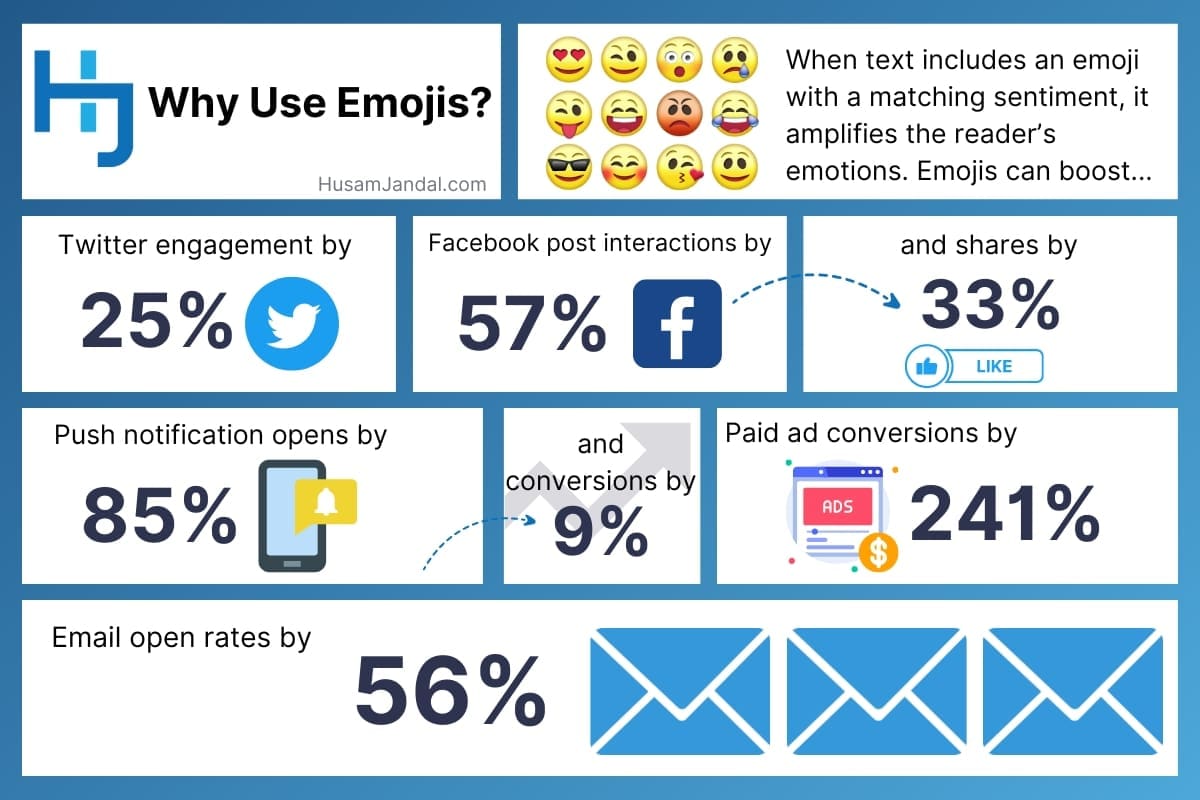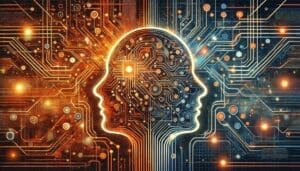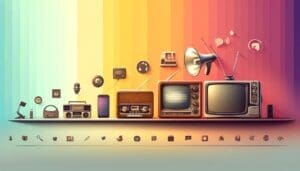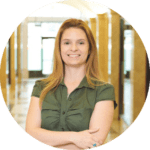 If a picture is worth a thousand words, the world has been saying a whole lot more since the introduction of emojis in the late 1990s. 🤩📢 Now utilized by 92 percent of the online population, according to Unicode, and with around seven million emojis sent each minute, per USA Today, it’s difficult to imagine digital communication without them. They’re an incredibly powerful part of a digital marketer’s toolkit, too. We’ll explore why they work so well and how to incorporate emojis into your digital marketing strategy on this page.
If a picture is worth a thousand words, the world has been saying a whole lot more since the introduction of emojis in the late 1990s. 🤩📢 Now utilized by 92 percent of the online population, according to Unicode, and with around seven million emojis sent each minute, per USA Today, it’s difficult to imagine digital communication without them. They’re an incredibly powerful part of a digital marketer’s toolkit, too. We’ll explore why they work so well and how to incorporate emojis into your digital marketing strategy on this page.
What Are Emojis?
“Emoji” is a compound word in Japanese. It blends 絵 (e), which means “picture,” and 文字 (moji), which means “character.” Each “picture character” has a unique Unicode code point or identifier that allows it to be read and interpreted universally, just like a letter. For instance, U+1F600 is the code point for the “Grinning Face” 😀 emoji.
This is why you can send a smile via text message from your iPhone to your friend using an Android, and they’ll see a similar smile. It’s also why this page can be typed in a word processing tool, transferred to a content management system, and subsequently read on virtually any device while ensuring everyone sees roughly the same picture characters embedded. 😉
It’s also worth noting that the plural for “emoji” can be either “emoji” or “emojis,” though the latter is more accepted, according to Grammarly.
A Brief History of Emojis
Two different Japanese telecommunications companies came out with variations of emojis in the late 1990s, as Discover Magazine reports. SoftBank, then known as J-Phone, launched the first phone with 90 built-in emojis in 1997. Shigetaka Kurita at NTT DoCoMo typically gets credit for being first despite releasing two years later because his versions were colorful, unlike J-Phone’s black images. Kurita’s goal was to make it easier for people to stay within a 250-character limit and reduce data usage, so he focused on developing 176 images to help share information. This boosted popularity, and emojis took off in Japan soon after.
The problem was that, at this point, there were no standards. Each company did its own thing, meaning it was hit or miss whether the person reading or receiving an emoji could see it. In 2007, a team at Google petitioned the Unicode Consortium, an organization that maintains text standards across computers, to begin recognizing emojis, Wired reports. Apple engineers then submitted a proposal to adopt 625 new emoji characters into the Unicode Standard in 2009. They got their wish in 2010. Apple iOS unveiled an official emoji keyboard in 2011. Android followed suit two years later.
Anyone can petition the Unicode Emoji Subcommittee to adopt a new emoji. There are now over 3,600 emojis on the Unicode Standard list, per Emojipedia. Firmly embedded in pop culture, the “Face with Tears of Joy” emoji 😂 was even named Oxford Dictionaries Word of the Year in 2015, the organization reports. And, when the “Father of Emoji” Shigetaka Kurita accepted the Webby Lifetime Achievement Award in 2023, he gave the first-ever five-emoji speech.
Emojis 😀 vs. Emoticons 🙂
Emojis share many traits with their predecessors, such as emoticons. This is unsurprising because Kurita drew inspiration from manga, Zapf dingbats (akin to the Wingdings font), and commonly used emoticons, MoMA reports. However, emoticons are literally “emote” and “icons.” They’re comprised of a series of characters and designed to show emotion. Emojis are usually pictographs, and most are displayed in color.
Benefits of Using Emojis in Digital Marketing
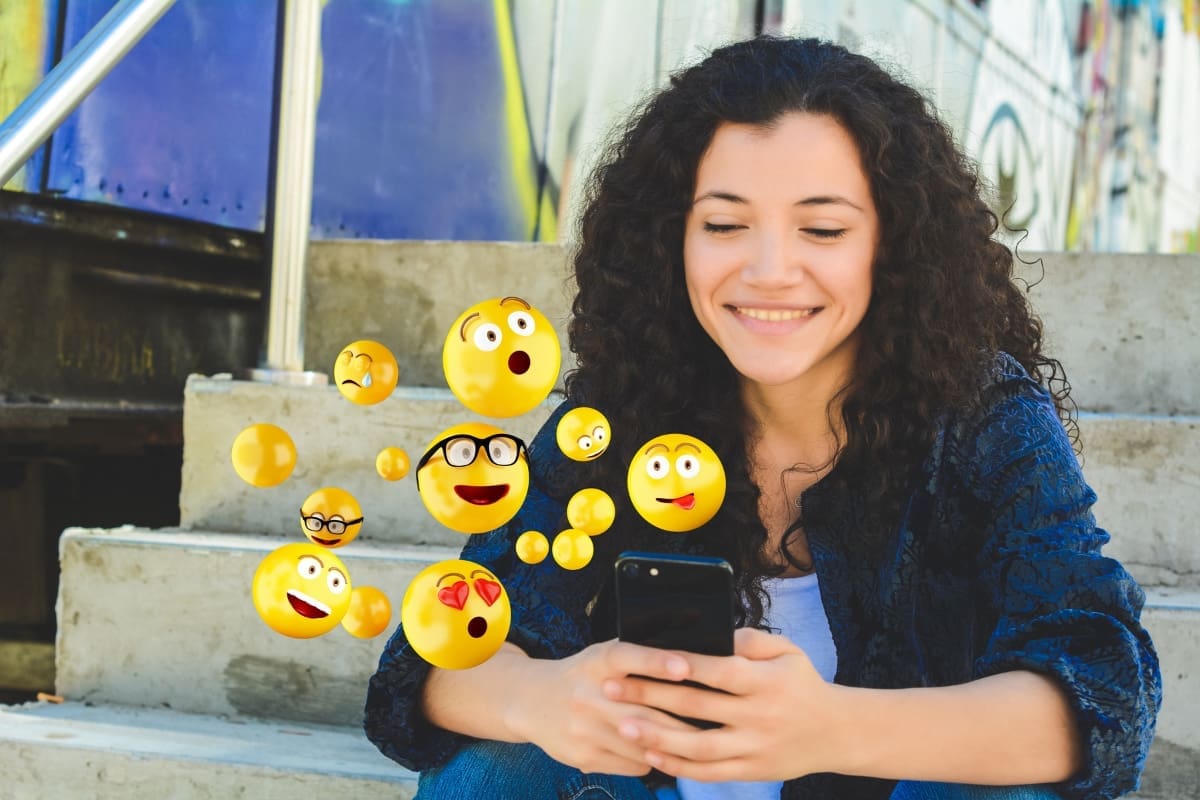
There are lots of benefits to including emojis in your digital marketing strategy.
Speak Like Your Audience
When you speak like the person you’re trying to connect with, your message resonates with them more. Because nearly the entire online population uses emojis and billions are sent daily, emojis are a good way to mirror how your audience speaks.
Humanize Your Communication
Brands can sometimes come off as robotic or impersonal. However, positive emojis actually increase the perceived warmth of the sender, per research published in Computers in Human Behavior.
Reinforce and Strengthen Emotions
Whereas positive emojis paired with positive messages boost perceived warmth, negative emojis increase perceived negativity when paired with negative messages, research shows.
Increase Message Comprehension Speed
When emojis match the message’s sentiment, processing speed and the understanding of a message increase. This means you can help people understand and perhaps retain your brand messages quicker when you leverage emojis. They’re also particularly powerful when people make split-second decisions about whether to consume your marketing materials, such as when opening an email or reading a text message.
Build Your Brand
When specific emojis are used regularly, they can reinforce branding and boost recall. They can also help showcase your brand’s personality.
Boost Engagement and Conversions
Countless case studies show emojis can increase the likelihood someone will interact with your marketing content and take action. For instance:
- Tweets get 25 percent more engagement when an emoji is included, per WordStream.
- Facebook posts get 33 percent more shares and 57 percent more interactions.
- Push notifications see an 85 percent increase in open rates, while conversions jump nine percent, HubSpot reports.
- Paid ads can see a 241 percent increase in conversions, per Ad Espresso.
- Email campaigns with an emoji in the subject line have a higher clickthrough rate (CTR), Search Engine Journal’s data shows.
Choosing Your Emojis
Before you start including emojis in your digital marketing campaigns, you must consider which emojis you want to leverage, what they mean, and whether the emojis you select have other meanings that might create confusion or cause issues.
One thing worth noting before we dig in here is that emojis can mean different things to different groups of people. There are no universally accepted definitions or uses for emojis. Furthermore, the meaning of emojis can change over time. You must use your own judgment about what’s right for your brand and audience.
Use Popular Emojis with Clear Meaning
Your best bets will typically be the most popular emojis because they’re more likely to be received how you intended. Let’s go over a few examples.
- 😂 Face with Tears of Joy: Something is so funny that it reduces you to tears.
- ❤️ Red Heart: Love.
- 🤣 Rolling on the Floor Laughing: Hysterical laughter.
- 👍 Thumbs Up: Approval.
- 😭 Loudly Crying Face: Intense emotion. Usually sadness, but it can also mean relief, laughter, or joy.
- 🥰 Smiling Face with Hearts: Love, friendship, or adoration.
- 😍 Smiling Face with Heart-Eyes: Falling in love or the equivalent of saying “aww…”
- 😊 Smiling Face with Smiling Eyes: Smiling but with warmth or humility.
- 🚀 Rocket: Progress or anticipation of significant changes.
- 💪 Flexed Biceps: Success or overcoming a struggle.
- 🎯 Bullseye: Reaching a goal or hitting your target.
- 🦋 Butterfly: Change, transformation, or beauty.
- 🤸 Person Cartwheeling: Joy or excitement.
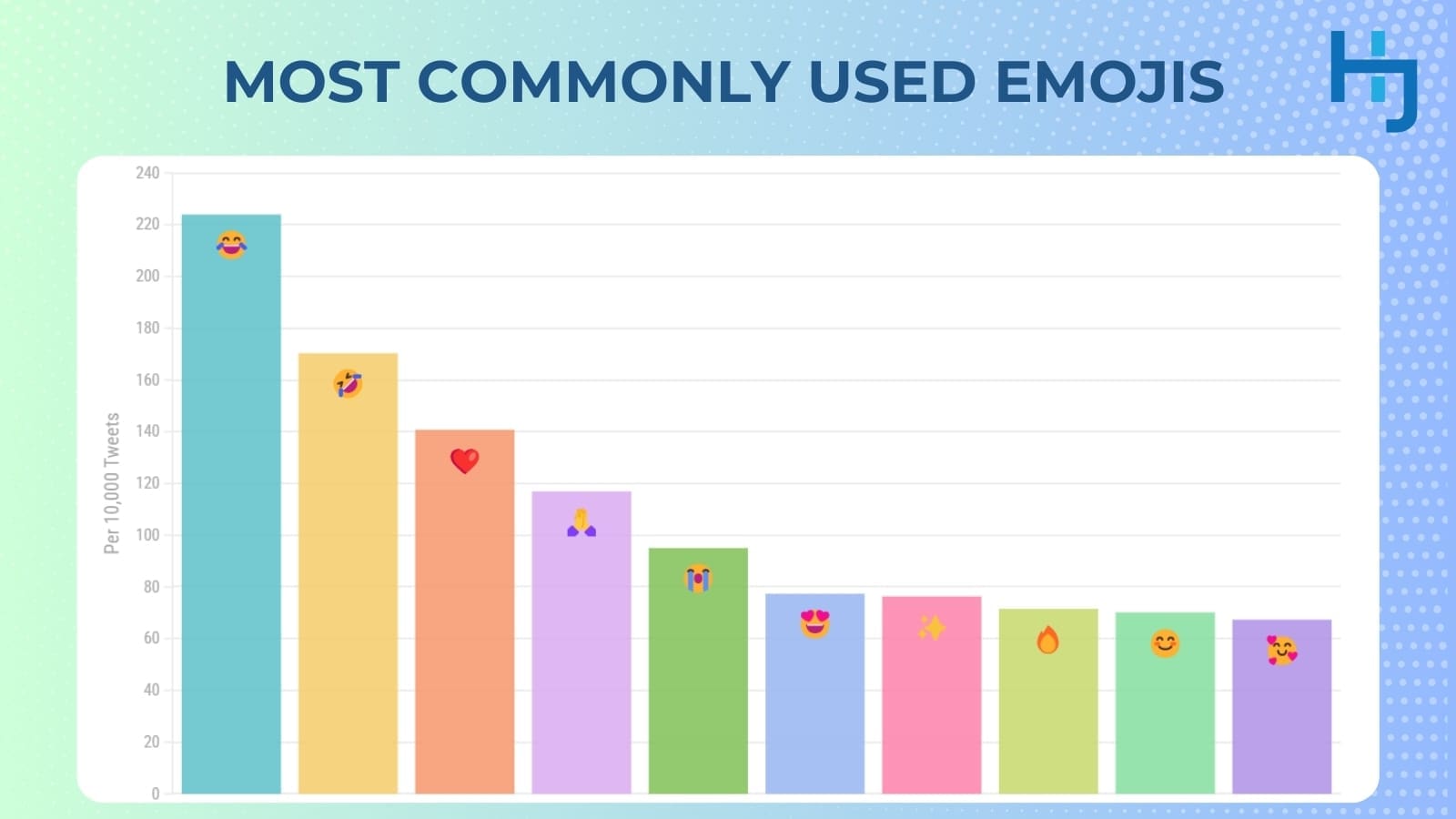
Experiment with Top Emojis to Boost Engagement
Certain emojis have been found to boost engagement, according to HubSpot. While these definitions are more open to interpretation and may not be ideal for every brand, you can experiment with them if you feel they are suitable.
- 🙆 Person Gesturing OK: Okay, or all good.
- 🍒 Cherries: A prize or treat. (This one can also mean something very different, so mind your context.)
- 🐠 Tropical Fish: Tropical locations or fish.
- 💃Woman Dancing: Represents dance or expresses excitement or confidence.
- 🌤️ Sun Behind Small Cloud: Can represent the weather but is also used in relation to solutions.
Try the Best-Performing Emojis for Clickthrough
Similarly, certain emojis are associated with higher CTRs. Like their engagement counterparts above, though, definitions are not universal, and you should ensure they’re suitable before trying them out.
- 🐙 Octopus: Cleverness, adaptability, or cuddling.
- 🐴 Horse Face: Usually represents an actual horse, though it can sometimes reference “horsing around.”
- 👖 Jeans: Used in relation to being comfortable or dressing casually.
- 🍒 Cherries: A prize or treat. (Again, this can mean something different, so mind your context.)
- 🚂 Locomotive: Usually refers to travel by train but can also mean “full steam ahead.”
Select Brand-Building Emojis
If a specific emoji resonates with your branding, you may consider using it with most of your communications. For example, McDonald’s uses French fries 🍟 a lot, while Spirit Airlines naturally makes liberal use of the airplane ✈️.
Meanwhile, Taco Bell desperately wanted a taco emoji that didn’t exist. So, it petitioned for one and turned it into a huge PR and marketing campaign. You now have Taco Bell to thank for getting you the taco emoji 🌮.
Be Careful When Using Confusing or Often Misused Emojis
Sometimes, even when an emoji might ordinarily make sense in a professional context, it can have multiple meanings or be misunderstood. A few that you might want to avoid for this reason are covered below.
- 💫 Dizzy: Many people see the stars and think this one is a space theme, but it represents being dizzy (seeing stars) or disoriented.
- 🤗 Hug: The hug emoji somewhat looks like it’s giving jazz hands. If you type “jazz hands” into an iPhone, it’ll even suggest this emoji. Because of that, some brands may use it to denote excitement and have customers think they’re sending hugs instead. Or, you might use it to denote that you care about a cause and give jazz hands at an inappropriate time.
- 💁 Information Desk: The information desk emoji is often confused with and used to display sarcasm or sass.
- 🙇 Bowing: Remember that emojis emerged in Japan, where bowing signifies respect. However, many Westerners see this same emoji as someone putting their head down as a sign of disinterest.
- 🙏 Folded Hands: Folded hands has a similar issue. It’s used when greeting or leaving someone in the east. However, the same emoji in the West often represents prayer, begging, or even a high-five.
- 😤 Face with Steam from Nose: This emoji was intended to show triumph. That concept never really took off, and it was frequently used to demonstrate anger. These days, you’ll see it more as a reference to smoking or vaping.
Tips for Making the Most of Emojis in Your Digital Marketing
At this stage, you should have a solid background in emojis. Let’s explore how to use them strategically in your digital marketing initiatives.
Don’t Expect Emojis to Carry Your Message
Think of emojis as the icing on the cake, not the cake itself. Would your message make sense if the emojis were removed? If not, adjust your copy so that it can carry your message alone. Then, add the emojis back in to strengthen it.
Be Mindful of Your Audience
Your audience, or more specifically, your personas, should guide your emoji selection and influence how you use emojis.
Emoji Meanings
Rolling on the Floor Laughing 🤣, Loudly Crying Face 😭, and Skull 💀, may seem different, but each can mean the same thing. Whereas those aged 30 and up will probably use the Rolling on the Floor Laughing emoji to represent laughing until crying, those under 30 are more apt to use the Loudly Crying Face for the same reason. Meanwhile, Gen Z and Generation Alpha are likelier to choose Skull as a way of saying they died of laughter.
Similarly, those over 30 are likelier to take a thumbs-up emoji at face value, while those under 30 may see it as a passive-aggressive sign or a way to end the conversation.
Keep these nuances in mind as you select emojis, and try to use the ones your audience uses the same ways they do.
Diversity
Most people don’t intentionally exclude groups from their marketing. However, this can happen if you habitually offer only partial representation in your emoji selection. To avoid this unintentional bias, try using neutral emojis, such as the yellow smileys or gender-neutral people, or develop a strategy to include better representation in your emoji selection.
Try Different Platforms
Emojis can be used in virtually all types of digital marketing, including:
- Social media
- SMS
- Push notifications
- Chat
- Paid ads
- And more
Experiment with Different Concepts
Emojis are versatile. For instance, you can:
- Ask social media followers to answer questions or vote with emojis.
- Try putting emojis at the front of a message versus the middle or end.
- Create puzzles for your readers to solve.
Experiment with different approaches in a brand-appropriate way to keep your content fresh and find out what your audience likes most.
Use Emojis in Moderation
Try not to overload your messages with emojis, especially those sent via email. They can be hard to understand, perceived as annoying, or even trip spam filters.
A/B Test
Run tests on everything from the inclusion of emojis to placement and types to get hard data about what your audience responds to and optimize your results over time.
Have Designated Approved Emojis
Because emoji selection can be challenging and must sometimes happen in the blink of an eye, it may be helpful to develop a list of emojis your team can use ahead of time.
Keep it Positive
While it’s okay to use negative emojis occasionally to show your audience you understand them and their frustrations, it’s generally best to use positive ones most of the time. Again, the emotion of the message is transferred to the poster, so if your messages are generally positive and warm, your brand may be perceived as more approachable, too.
Make it Work for Your Brand and Get Creative
Taco Bell, with its demand for a taco emoji, is not the only brand that’s gone off the beaten path. Dominos, for example, launched a campaign that allowed customers to order pizza by texting the pizza emoji. A UK optician used a “spot the emoji” campaign to encourage people to test their vision. Even the White House dipped its toes in the water with the White House Millennials report. If you’re excited about a novel or unique idea, try it!
Consider How Your Emoji Looks on Different Devices
While the look of emojis is fairly standardized, they’re not identical on different devices and platforms. As you start using emojis, it might be helpful to view Unicode’s complete emoji list to see how your intended images will display on different platforms.
Evaluate Your Mix
Sometimes, the meaning of a single emoji is dramatically different when paired with something else. For instance, the cartwheel emoji 🤸 denotes excitement. However, if you put a hole in front of it 🤸🕳️, it shows disaster is looming. Proofread your messages and have someone else check them before publishing them to avoid these mistakes.
To Emoji or Not to Emoji
Emojis aren’t suitable for every brand or in every circumstance. Sometimes, they can actually hurt your results. For instance, emojis can help improve your email marketing. Simply by including a wrench in the subject line around Father’s Day, one brand boosted inbox placement by eight percent and open rate by one percent, Business Wire reports. Including the lips emoji near Valentine’s Day boosted opens by four percent on another campaign. Yet, including the champagne glasses emoji at New Year’s reduced opens and inbox placement.
Similar results occurred with Search Engine Land’s test. While emojis were shown to improve their CTRs, spam reports skyrocketed when they included the newspaper emoji with their newsletter subject line.
In other words, emojis can produce varying results. Moreover, the emojis you choose and how you place them can make a difference, too. What works for one brand may not work for another. The best way to know what works for your business is to experiment and track your results.
Get Help Strengthening Your Digital Marketing Strategy
As a digital marketing consultant, I encourage my clients to identify which emojis are suitable for their brand and experiment with what works best. They can create surprisingly dramatic results when used as part of a comprehensive digital marketing strategy. If your business isn’t getting the results it needs from digital marketing, or you’re struggling with optimizing any aspect of your digital marketing, I can help. Contact me for a complimentary consultation.
